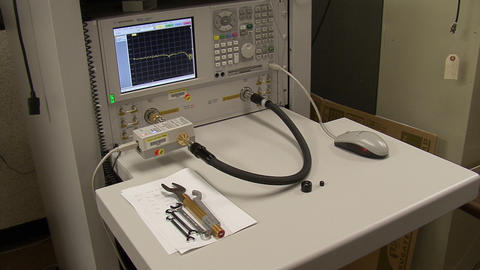
Verifying the performance of vector network analyzers—devices that check how components used in cell phones, radios and satellites transmit signals—has gotten a lot easier and faster with this plug-in device and accompanying software developed by NIST. A process that once took hours or days can now be done in minutes.
Verifying the accuracy of network analyzers--instruments that are used to measure key performance characteristics of electronic networks--was once an awkward process involving multiple steps and pieces of equipment. Now, thanks to an electronic verification standard and accompanying software developed by electrical engineers at the National Institute of Standards and Technology (NIST), much of that process can be automated and the performance of the calibration system checked with NIST via the Internet. Results are both more complete and available in a matter of minutes, not hours or days as once was the case.
So-called "vector network analyzers" (VNAs) have become workhorse tools for checking how well complicated electronic components—systems used in cell phones, wireless Internet links, radar components, radios and satellites, for example—transmit signals. Until now, calibrating VNAs involved plugging a number of mechanical artifacts with known performance characteristics into the testing machines and running tests on that individual artifact. Then another artifact with different characteristics would be swapped out, measured, recorded, etc. This took up to an hour to complete, the artifacts were expensive, and the measurements were not always reliable.
NIST electronics engineer Dylan Williams and team has eliminated much of that complexity with a new verification procedure based on a device with a wide variety of measurement characteristics that plugs into the computer being used to do the calibration.* By using the software tool provide by NIST, a equivalent calibration can be done quickly via automation—the user doesn't have to play an active role in the process.
Williams said this new procedure also has the benefit of being traceable directly to NIST labs, comparing measurements to an independent calibration process and authenticating the tests both electronically and with a printable certificate from NIST that includes the serial number of the device being calibrated.
"Every time a vector network analyzer, a common electrical measurement instrument, took a measurement, it would measure eight different parameters at once and you were never sure if it was measuring them all correctly," Williams says. "It has been a nagging problem for some time with no real way to check it. Now, you can verify the performance of your analyzer and cover the whole space of what the instrument can measure."
With thousands of vector network analyzers in use by industry every day, Williams expects there to be a constant demand for their verification devices. For further information on obtaining the software and one of the hardware devices needed for the calibration procedure, contact Ronald Alan Ginley at (303) 497-3634, ronald.ginley [at] nist.gov (ronald[dot]ginley[at]nist[dot]gov).
D.F. Williams, A. Lewandowski, D. LeGolvan and R. Ginley, Electronic vector-network-analyzer verification. IEEE Microwave Magazine, pp. 118-123, October, 2009.
D.F. Williams, A. Lewandowski, D. LeGolvan, R. Ginley, C.M. Wang and J. Splett, Use of Electronic calibration units for vector-network-analyzer verification. 74th ARFTG Microwave Measurement Conference, Boulder, Colo, Dec. 1-4, 2009.

